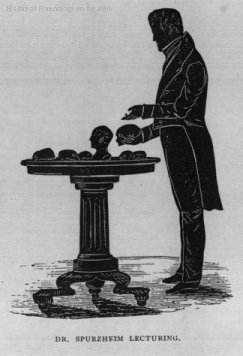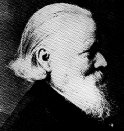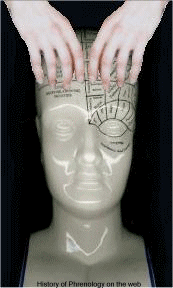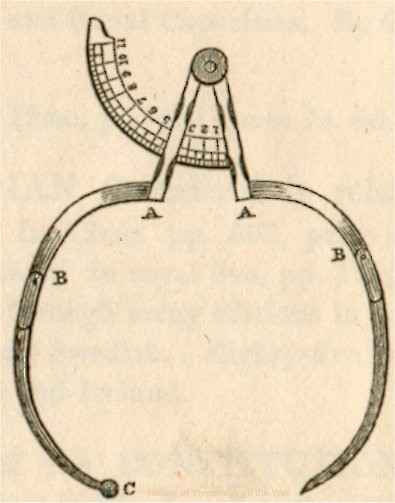"[Before
phrenology] all we knew about the brain was, how to slice it..."
R. Chenevix
(phrenologist), 1828.
|
|
Phrenology was a science of character divination, faculty psychology, theory of brain and what the 19th-century phrenologists called "the only true science of mind." Phrenology came from the theories of the idiosyncratic Viennese physician Franz Joseph Gall (1758-1828). The basic tenets of Gall's system were:
1.The brain is the organ of the mind.
2. The mind is composed of multiple, distinct, innate faculties.
3. Because they are distinct, each faculty must have a separate seat or
"organ" in the brain.
4. The size of an organ, other things being equal, is a measure of its power.
5. The shape of the brain is determined by the development of the various
organs.
6. As the skull takes its shape from the brain, the surface of the skull
can be read as an accurate index of psychological aptitudes and tendencies.
(For a description in Gall's own words see: Letter
to von Retzer)
So it was believed that by examining the shape and unevenness
of a head or skull, one could discover the development of the particular
cerebral "organs" responsible for different intellectual
aptitudes and character traits. For example, a prominent protuberance in
the forehead at the position attributed to the organ of Benevolence
was meant to indicate that the individual had a "well developed" organ of
Benevolence and would therefore be
expected to exhibit benevolent behaviour. 
However, like so many popular sciences, Gall and the phrenologists sought only confirmations for their hypotheses and did not apply the same standard to contradictory evidence. Any evidence or anecdote which seemed to confirm the science was readily and vociferously accepted as "proof" of the "truth" of phrenology. At the same time, contradictory findings, such as a not very benevolent and disagreeable person having a well-developed organ of Benevolence were always explained away. This was often done by claiming that the activity of other organs counteracted Benevolence. What was never accepted by phrenologists, however, was that admitting that the activity of a particular faculty could be independent of the size of its organ undermined the most fundamental assumptions of the science- and thereby rendered all of its conclusions inconsistent and meaningless. (For a more in depth account of the origins of phrenology see: van Wyhe 2002.)
The history of phrenology can be divided into three general
phases. The first, extending roughly from the mid-1790s to the 1810s,
saw only the Germans Gall and his disciple J.G.
Spurzheim  as
the practitioners and advocates of the science. From 1815 a damning
review in the prestigious Edinburgh Review launched
the science into general public view in the English-speaking world
instead of being restricted to elite medical journals. From this
time forward many more middle-class men took up phrenology as a scientistic
pursuit. These first phrenologists sought to achieve recognition
for themselves as students of the greatest of all the sciences. It
was meant to be a certain science of human nature. Spurzheim faced
down and refuted his Edinburgh
Review critic and thereby won many converts in Edinburgh. The first
phrenological society was founded in Edinburgh in 1820, and many more
followed throughout Britain and America in later decades. In addition
to societies these men established subject journals, modelled on existing
scientific journals and the Phrenological Association, which first met
in 1838, to mimic the British Association for the Advancement of Science
(from which phrenology had been excluded). See Timeline
and the 'Introductory Statement'
to the Phrenological Journal, 1823.
as
the practitioners and advocates of the science. From 1815 a damning
review in the prestigious Edinburgh Review launched
the science into general public view in the English-speaking world
instead of being restricted to elite medical journals. From this
time forward many more middle-class men took up phrenology as a scientistic
pursuit. These first phrenologists sought to achieve recognition
for themselves as students of the greatest of all the sciences. It
was meant to be a certain science of human nature. Spurzheim faced
down and refuted his Edinburgh
Review critic and thereby won many converts in Edinburgh. The first
phrenological society was founded in Edinburgh in 1820, and many more
followed throughout Britain and America in later decades. In addition
to societies these men established subject journals, modelled on existing
scientific journals and the Phrenological Association, which first met
in 1838, to mimic the British Association for the Advancement of Science
(from which phrenology had been excluded). See Timeline
and the 'Introductory Statement'
to the Phrenological Journal, 1823.

From its beginnings as a social activity in Britain, phrenology attracted the enthusiastic and the arrogant. Such persons found "one of the most valuable discoveries that ever graced the annals of philosophy" to be just the thing for them to enter the burgeoning world of scientific societies. Furthermore, one could enter that world at the head. Many of these early phrenologists were political and social reformers and a few were ultra radicals- and many of the histories of phrenology describe phrenology as a reformist or radical science. However, phrenology was also of interest to many who were not intent on bringing about social or political change. Many devout evangelicals saw in the organs Veneration and Wonder additional evidence for the design of a creator. Several Christian phrenological societies were founded by these individuals. Most phrenologists, however, were much more secular. They made phrenology a seminal environment for the beginnings of 19th-century self-help philosophies, scientific naturalism, and secularization generally. Nevertheless, it cannot be ignored that the majority of people convinced by phrenology had not social or political agenda but found the theory of cerebral localization of character traits plausible. For practitioners of phrenology the science bestowed an awesome authority which, they claimed, could not be matched by any other science.
From Britain phrenology spread to America and France in the
1830s and in the1840s it was re-introduced to Germany. It became far more
successful in America. Phrenology died away in Britain by the early 1850s
but a new movement was re-introduced to Britain by the American "phrenological
Fowlers" in the 1860s and 1870s.  The
Fowlers had begun lecturing and reading heads
for fees in New York in the 1830s. Their phrenology was wholly borrowed
from the British modifications of Gall's system. The Fowlers swept through
Britain on a successful lecture tour before establishing various phrenological
institutions, societies and publishing concerns. Less scientifically pretentious
and more overtly entrepreneurial, it is largely this latter-day phrenology
whose remnants are still seen today. A phrenological
bust in an antique shop will almost invariably bear the label "L.
N. Fowler". The latter phrenology movement was largley responsible for
the anthropometric (head reading) craze of the latter 19th century and its
well-known anthropological/racial
concerns. The early phrenological movement was concerned more with providing
practitioners with claims to epistemological certainty and intellectual
authority than disscussing human races.
The
Fowlers had begun lecturing and reading heads
for fees in New York in the 1830s. Their phrenology was wholly borrowed
from the British modifications of Gall's system. The Fowlers swept through
Britain on a successful lecture tour before establishing various phrenological
institutions, societies and publishing concerns. Less scientifically pretentious
and more overtly entrepreneurial, it is largely this latter-day phrenology
whose remnants are still seen today. A phrenological
bust in an antique shop will almost invariably bear the label "L.
N. Fowler". The latter phrenology movement was largley responsible for
the anthropometric (head reading) craze of the latter 19th century and its
well-known anthropological/racial
concerns. The early phrenological movement was concerned more with providing
practitioners with claims to epistemological certainty and intellectual
authority than disscussing human races.
Phrenology evolved into wider and wider cultural space over time, beginning
with Gall and the highest scientific and social and cultural elites, from
Goethe to the king of Prussia, to the British and American scientifically
pretentious middle-class phrenological societies of George
Combe and finally to the disreputable practical "professors" of phrenology,
reading heads for profit and the mass audiences of the Fowlers to the dawn
of the 20th century. So-called "practical" phrenologists like
the Fowlers, far outnmubered, in the long run, the interested medical men,
the scientifically pretensious and theoretical phrenologists. Many orignal
texts are available at this site which portray a broad range of phrenological
literature- from high brow to low brow.

Phrenologizing involved mostly head reading and character
analyses as well as speculation on the interactions between the faculties
(which were spoken of as if each were a selfish homunculus, seeking its
own gratification). Most phrenologists would run their bare finger tips
(Gall recommended using the palms of the hands) over a head to distinguish
any elevations or indentations. Sometimes callipers,  measuring
tapes and other instruments were used. A skilled phrenologist knew not just
the cartographic layout of the head according to the latest phrenological
chart, but also the personalities and pros and cons, of each of the 35 odd
organs (the number of organs gradually increased over time, see: the
Phrenological organs). Phrenologists also diagnosed one's temperament
or humour- an oft forgotten component of phrenology. See a chapter from
Donovan's A
Handbook of Phrenology (1870) for a more detailed description and
illustrations for head reading.
measuring
tapes and other instruments were used. A skilled phrenologist knew not just
the cartographic layout of the head according to the latest phrenological
chart, but also the personalities and pros and cons, of each of the 35 odd
organs (the number of organs gradually increased over time, see: the
Phrenological organs). Phrenologists also diagnosed one's temperament
or humour- an oft forgotten component of phrenology. See a chapter from
Donovan's A
Handbook of Phrenology (1870) for a more detailed description and
illustrations for head reading.
For an amusing late 19th-century personal reminiscence of being phrenologized, click here. And for the character analysis and career advice for girl under the age of seven in 1912, click here.
In the early days of phrenology, phrenologists often met weekly or bi-weekly at their local phrenological society. Here they would hear a lecture and marvel over new confirmations of phrenology. They often kept small libraries of phrenological works and museums of phrenological busts, skulls, and casts of the heads of the famous and infamous or examples of different "races" of humans.
During phrenology's first heyday in the 1820s-1840s, many employers could demand a character reference from a local phrenologist to ensure that a prospective employee was honest and hard-working. This belief that the protuberances on the skull provided an accurate index of talents and abilities was particularly urged to be applied to education and criminal reform. Phrenologists, not unlike those who today believe in strong demarcations in "left-" or "right-brains", thought they could determine the most suitable career for the young and match prospective mates with greater accuracy than 'old-fashioned love'. Visiting a phrenologist was akin to seeking the advice of so-called psychics, clairvoyants or astrologers today. A phrenologist was someone who claimed to have access to special knowledge about people. The ignorant and gullible were particularly susceptible to the pretensions of phrenologists.

Phrenology was spread, from the days of Gall, through the end of the 19th century, largely by itinerant lecturers, as was mesmerism. A pamphlet by a typical "practical phrenologist" is H. Lundie's The Phrenological Mirror. This pamphlet includes the prices for providing delineations, the meaning of each organ per its size (some of which are quite amusing) the four classical humours or temperaments as appropriated by the phrenologists, and two brief sections on how one ought and ought not use one's organs. In effect, Lundie's pamphlet, like most phrenology texts, was to serve as an owner's manual for the human brain.
Phrenologists also spent considerable time and effort in defending themselves and their science from criticism- always ready to portray themselves as Galileo-like defenders of natural truth, condemned by bigoted religious and close-minded scientific critics. Identical arguments are used today by charlatans of all descriptions who claim to have special knowledge or abilities. Those too rational or cautious to believe without evidence are dismissed as "close-minded".
Phrenology has been almost universally considered completely
discredited as a science since the mid-19th century. Even during the peak
of its popularity between the 1820s and 1840s, phrenology was always controversial
and never achieved the status of an accredited science, which was so coveted
by its main proponents, such as  the
Edinburgh lawyer, George Combe and his circle.
the
Edinburgh lawyer, George Combe and his circle.
Rather than portraying phrenology as having succumbed to an
inexorable progress of 'science' or representing the Victorians as having
become less 'gullible', phrenology can be understood to have been diffused
and absorbed into a host of other practices and traditions- as such many
of its components live on. Alison Winter uses a similar approach to understand
the 'disappearance' of mesmerism. Phrenology, as all popular fads, eventually
became deeply unfashionable amongst the well-to-do who had previously espoused
it. It had degenerated into a sect of zealous extremists. Many of the first
generation phrenologists were unable to pass on their discredited knowledge
to a new generation which had many more opportunities to participate in
popular sciences. Nevertheless, the British Phrenological Society (founded
by Lorenzo Niles Fowler in 1887) was only disbanded in 1967.
A legacy of phrenology lived on in other projects of measuring and comparing
human heads- most notoriously the attention to cranial size, forehead shape
etc. used by late 19th and early 20th century racial anthropologists to
confirm their belief that Europeans were superior to other humans. Paul
Broca was prominent in this movement and he helped establish the Anthropological
Society in Paris in 1859.
The history of phrenology is now of interest to historians and those seeking the early roots of modern cerebral localization and neuroscience. Methodologically problematic as it was, phrenology was the first system to attribute psychological behaviour to localized regions of cerebral cortex, an approach that has, with refinements and exceptions, been increasingly vindicated since the 1860s following the work of Pierre-Paul Broca and others in France and Carl Wernicke in Germany in the 1870s. Other main principles of phrenology were generally confirmed at the end of the 19th century by the work of David Ferrier, J. Hughlings Jackson, John Bucknill, James Crichton-Browne and Charles Sherrington.
Ironically, most of phrenology's basic
premises have been vindicated, though the particulars of reading character
from the skull have not. For example, the principle that many functions
are localized in the brain is now a commonplace (although many other functions
are distributed). Also, areas of the brain that are more frequently used
(as the right hippocampus of London taxi drivers) may become enlarged with
use. (See The Journal of Neuroscience,
vol. 17, 1997.) This is exactly what phrenologists asserted.
Some personality or speech disorders correlate to specific atrophied regions
of the brain. From this we conclude that the affected part of the brain
was either necessary for or simply was that bit of the personality
or ability. Modern brain imaging techniques, such as functional magnetic
resonance imaging (FMRI) make the localization of functions demonstrable
beyond doubt.
Palaeontologists make endocasts from the skulls of early hominids to determine
the shapes of their brains and have suggested that an enlarged node at Broca's
region is evidence of language use. This is essentially phrenology in a
new guise. Size is taken as evidence for power and functions are believed
to reside in specifcally bounded regions.
All of the 'organs' or bumps identified by phrenologists
are now considered purely imaginary except for Gall's 'faculty for words
or verbal memory'- which was close to the present location of Broca's and
Wernicke's speech areas. However, following Spurzheim's
modifications of Gall's system, later phrenology abandoned this only
correct organ!
And finally, today we know that what was traditionally called "the mind"
is indeed nothing more than functioning human brain.
See Other websites about phrenology and the
bibliography for more information.
Phrenology: This term came into general use around 1819/1820 in Britain where it was coined by the physician T.I.M. Forster in 1815. It is derived from the Greek roots: phren: 'mind' and logos: 'study/discourse'. Gall himself never approved of the term phrenology. He called his system simply organology and Schädellehre and later simply 'the physiology of the brain'. The name phrenology really shows the far-reaching pretensions of the phrenologists to extend their authority over a greater area than just cerebral anatomy.
Craniology and cranioscopy: Additional, older terms for phrenology. Contrary to what is often alleged, these terms were not favoured or used by Gall, nor did they originally have different meanings. These two terms, and other variants (such as craniotome, craniognomy, or craniognosy), were used indiscriminately to refer to the doctrines of Gall and the phrenologists before the term phrenology was seized upon by Gall's former pupil, and the Saint Paul of phrenology, J.G. Spurzheim and the more pretentious British phrenologists. Beginning in the mid-1840s a new use for the term cranioscopy arose, meaning specifically the study of the size, shape, etc. of the skull, especially those of various 'races', as a part of an overtly scientific anthropology. This use was first made by the German physiologist and psychologist Carl Gustav Carus (1789-1869).
Physiognomy, the study of internal character from external appearances- most notably the face- was a partly aesthetic and partly philosophical practice which preceded phrenology (its roots lay as far back as the middle ages). Its main advocate in the late eighteenth century was the Swiss clergyman J. G. Lavater (1741-1801) in his Physiognomical Fragments (1775-8). See Other Physiognomies. A few physiognomical works are available on-line, see: Other phrenological texts on-line.
Faculty: phrenologists believed "the mind" was divided into a number of discrete departments, each specialized for certain tasks or tendencies, e.g. "the faculty of Benevolence means every mode of benevolent feeling induced by means of the organ of Benevolence." The cerebral organs and their faculties carried the same names- so the lists of organs provided at this site are also lists of mental faculties. Other faculty psychologies contained faculties like memory, reason, intellect and so on. See: Phrenological Organs.
Organ: the "material instrument" by which a particular faculty was believed to operate. The size of an organ was the measure of its power or activity. The skull was said to take its shape from the underlying brain and hence, the larger or smaller an organ, the skull above it was expected to reflect this development. (Phrenologists pointed to cases of hydrocephalus, collection of water in the brain, in which the skull can become grotesquely distended while brain function may be unimpaired). The phrenological organs were mirrored in each hemisphere which is why some busts only have organs marked on one side. (i.e. there were two of each except Amativeness.) Phrenological Organs
Bumpology: is probably one of the best-known aspersions used to lampoon phrenology. See: Ridiculing Phrenology.
Pseudoscience: Historians of science tend no longer use this term as it is widely considered to be biased and judgmental. It implies the application of a current conception of science, and proper scientific attributes, onto historical phenomena. Such value judgments about the so-called virtues and vices of historical subjects are now seen as outside the scope of historians' projects. Many historians of science today consider the use of this term naive. Nevertheless the word was sometimes used by contemporaries to describe phrenology.
Further reading:
For a more in-depth look at the beginnings of phrenology see my article 'The authority of human nature: the Schädellehre of Franz Joseph Gall', British Journal for the History of Science, March, 2002, pp. 17-42. For the following history of phrenology in Britain and especially the naturalism that came out of it see my book: Phrenology and the origins of Victorian scientific naturalism (2004). (Amazon link)
The most complete primary source on phrenology on the internet is Combe's A System of Phrenology, 2 vols., 5th edn, 1853. See also Spurzheim, Phrenology: or the doctrine of the mental phenomena. For a quick overview see: Spurzheim, Outlines of Phrenology; being also a manual of reference for the marked busts. London, 1827. [Illustrated html]
Have a look at the next page: Phrenology in Literature some of the best selling Victorian books were influenced by phrenology.
Also of interest: Ridiculing Phrenology. No science was ever abused so much- but what effect did that have?
Acknowledgements: Many people have kindly contributed to this project including: Aileen Fyfe, Jim & Anne Secord, Cordula van Wyhe, Lisle Dalton, Wolfgang Schütz, Anthony Walsh, John Henderson, and Antranig Basman.
© John van Wyhe 1999-2011. Materials on this website may not be reproduced without permission except for use in teaching or non-published presentations, papers/theses.